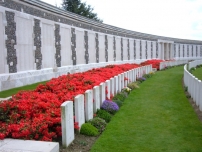| First Name: | William Albert Victor | Last Name: | MASON | |
|---|---|---|---|---|
| Date of Death: | 24/08/1917 | Lived/Born In: | Stockwell | |
| Rank: | Lance Corporal | Unit: | King's Royal Rifle Corps8 | |
| Memorial Site: | Tyne Cot Memorial, Belgium | |||
Current Information:Born-Lambeth
Third Battle of Ypres This was a campaign fought between July and November 1917 and is often referred to as the Battle of Passchendaele, a village to the north-east of Ypres which was finally captured in November. It was an attempt by the British to break out of the Ypres salient and capture the higher ground to the south and the east from which the enemy had been able to dominate the salient. It began well but two important factors weighed against them. First was the weather. The summer of 1917 turned out to be one of the the wettest on record and soon the battlefield was reduced to a morass of mud which made progress very difficult, if not impossible in places. The second was the defensive arrangements of concrete blockhouses and machine gun posts providing inter-locking fire that the Germans had constructed and which were extremely difficult and costly to counter. For 4 months this epic struggle continued by the end of which the salient had been greatly expanded in size but the vital break out had not been achieved. On 18th August, 1917, 14th Division began the relief of 56th Division after the latter had suffered many casualties during the Battle of Langemarck when they had attacked towards the Gheluvelt plateau. 41 Brigade, including 8th King’s Royal Rifle Corps were in reserve on 22nd August when 43 Brigade took up the offensive again and attacked astride the Menin road, which ran in a south-east direction from Ypres. Most of the objectives were reached but German counter attacks threatened this success so at midday, 8th King’s Royal Rifle Corps were moved up to Sanctuary Wood under shell fire. That evening they moved into the old front line, from which the attack had been launched, which ran from Clapham Junction to Stirling Castle. The next day passed quietly enough for 8th King’s Royal Rifle Corps but that night, as the battalion prepared to be relieved, enemy shelling of their positions increased considerably. Despite this the relief continued and half of the battalion moved back to Zillebeke Bund but Battalion HQ and one and a half companies remained behind to form a defensive flank facing south from Inverness Copse to Stirling Castle. At 4.30am on 24th August the Germans launched their counter attack and using flame throwers and bombers, the forward posts of 43 Brigade were pushed back to their original starting positions. The line held by 8th King’s Royal Rifle Corps came under heavy pressure, especially from the German artillery but it held and was strengthened by the return of the companies from Zillebeke. Throughout the day they remained here under constant shell fire which accounted for nearly all of the 100 casualties sustained by the battalion, one of whom was William Mason. That evening 8th King’s Royal Rifle Corps were relieved. |
||||
| « Back to Search Results | ||||
| If you think any of the information shown here is incorrect, Click Here to submit your amends and comments | ||||




